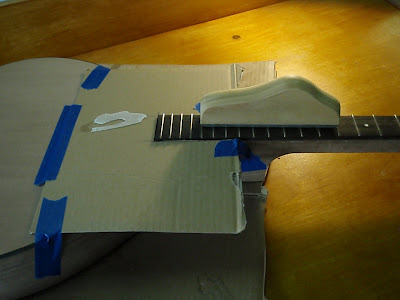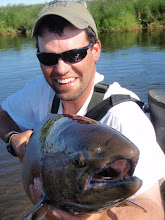After the fretboard had dried overnight I unclamped it and reattached the neck to the box. I also placed a protective cover over the soundboard in case of any slips while leveling. Using a fret file that I purchased from Stew-Mac I went about the process of initial leveling. After a few passes all of the frets were level (N.B., to find level I kept checking with a straightedge).

Next, I cut a 30 degree angle on the fret ends using a homemade file-gizmo. I took a scrap piece of 2"x4", cut some slots in it which help stop metal shavings from maring the fretboard, and cut the 'handle' at a 30 degree angle on the table saw (you could use a band saw just as easily). Then I placed a strip of double-sided tape on the block and attached a file. Moving back and forth on both sides of the fretboard, holding the file tight to it, I was able to achieve the angle on the fret ends that I wanted.

After that was completed, I used a number of small sanding blocks to polish the frets - going from 120 grit up to 2000 grit.

I then taped between the frets. Using a small triangle file I 'rounded' the fret ends by using a downward sweeping motion right-to-left and then left-to-right on each of the frets. This helps to remove any rough spots on the fret ends. When that was completed, I hit the frets with some steel wool, and removed the tape to see a nice shine.

The next thing on the agenda was to cut out the peghead. Finding the centerline, I traced out the pattern on the peghead veneer. To get the proper angle for the headstock, nearest the nut, I clamped the neck into the jig and started cutting it out.


However, I didn't want the sides of the rest of the peghead to be angled, so I traced the pattern on the back of it in order to have a flat surface (i.e., the 'top' of the peghead) on which to cut. But, I ran into a little bit of an issue - the fretboard, nearest the nut, would not allow the peghead to sit flat on the bandsaw table. To correct for this, I planed down some scrap wood the thickness of the fretboard and attached it, using tape, to the top of the peghead. This allowed me to get a nice cut.



To finish up, I initially sanded the cut sides using a sanding drum on the drill press, and then finished them by hand sanding down to 320 grit.

















